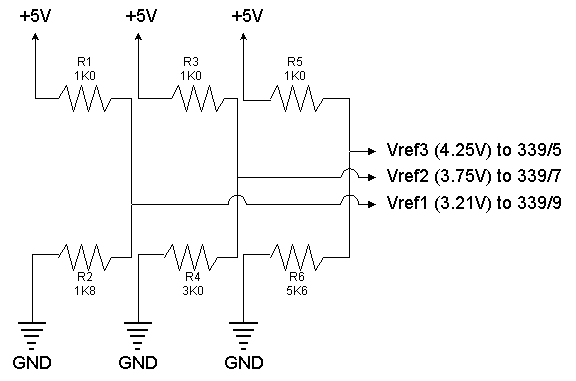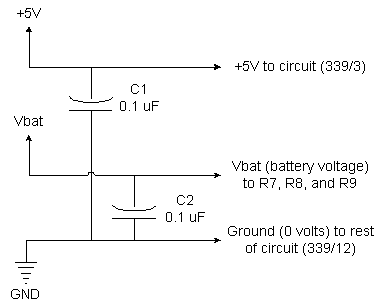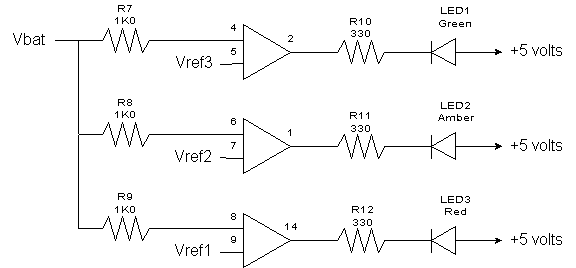|
The circuit is designed
to be fitted into a small box and then fitted into your
backbox (the exact choice of position is yours). Only 3
wires are required - one for the battery +v, one for the
supply +5 volts from the MPU board or power supply and a
common return to ground. The circuit is designed for 4.5
volt battery packs (3 cell x 1.5 volts). The circuit
gives level indication using 3 LED's - one green (good),
one amber/yellow (mid) and one flashing red LED
indicating low battery power - 3.2v or less approx.
I think a 1.3-1.5 volt
drop should be enough warning - I can't guage the
drop-out voltage for CMOS memory standby in WPC games
because of the ASIC, so, I've gone for what you see
here.
3 comparators compare the
incomming battery voltage against 3 reference voltages
provided by 3 potential dividers (see schematic), the 3
comparators directly drive the LED's by sinking current
to ground (internal). On power-up, the Green LED will
always be on indicating good battery power. As the
battery voltage drops, the amber LED will light,
followed by the red flashing LED, the previous LED's
remain on until all the LED's are lit.
I designed the circuit in
this manner to cut down the component count and make the
building easier. If you wish to modify the circuit so
that LED's will extinguish one after the other - I
suggest you use a 74HC03 quad NAND gate with open-drain
outputs to sink the LED current, and, who's input's is
switched by next comparator in sequence thereby turning
the previous gate off (I would have given the schematic
details here but I don't have the IC handy to
incorporate into the design at the time).
IMPORTANT NOTE: If your
battery pack provides 4.21 volts or greater when new
then all the leds will remain off. In most cases, new
batteries do not always put out their specified voltage
- a small voltage drop is usual.
A decent soldering iron,
a side-cutter, a small flat blade or philips 0
screwdriver, a digital volt meter (DVM) or oscilliscope
are all you need.
Okay, lets make a start -
the circuit schematic:
[Circuit copyright -
Clive Jones 7/1996]
339/n = connect to LM339
comparator pin "n"



The potential divers -
R1+R2, R3+R4 and R5+R6 provide the reference voltages.
If you wish to modify the circuit to output different
references, then the potential divider voltage can be
given by the formula:
5(v) x R2
---------
R1 + R2
Building Instructions
The circuit should fit on
a board 2"x 2". Build the potential divders/voltage
references first, supply them with +5 volts and ground
(don't forget capacitors C1/2) and measure the output -
they should be approx the figures given.
Next:- add a 14 pin
socket (absolutely vital) to the board and run the
reference voltages to the correct pins according to the
schematic, then +5 volts and ground - now measure the
voltages at the socket to ensure they're present.
Next:- add R7-R9 to the
board at the pins specified and link the other 3 ends together.
Next:- Build the
following battery failure simulator on another small
board then jumper the output to the Vbat line where
R7-R9 are joined together:

Next:- trim the 10k
linear pot and observe voltage changes at 339/5,7 and 9.
Next:- add the 330 ohm
LED current limiting resistors R10-R12 followed by the
LED's to the board (or mount them on small flyleads for
fitting to the box cover).
Last but not least - add
the LM or CA339 quad comparator and power up. You should
have the green LED on (exception, battery >4.21v) - now
rotate the 10k pot and the LED's should light in
sequence - green, amber then flashing red. If they do
not then power down and CHECK YOUR CONNECTIONS.
If the circuit works
correctly then removed the Vbat sim. and add the 3
flyleads to allow connection to the MPU board of your
game. I suggest you use a red wire for +5 volts, a black
wire for ground and another wire of you choice for the
Vbat line.
Add all the bits into a
little box and mount the box onto the backbox wall. I
suggest that you actually drill holes in the cover for
the LED's to protrude through, or, connect them to the
board with small flyleads and glue them into the box
cover.
Solder the flyleads to
the MPU board with the POWER OFF. Allow the board 2
minutes before soldering in the leads as the onboard
capacitors may still hold a charge.
USE COMMON SENSE! - don't
tap the +5 volts for the circuit from a chip leg - find
a free pad on the board that you can tap from. Wire the
battery power from the pack were it enters the board and
return to a suitable earth point.
KEEP IT NEAT! - Take
pride in you work - make the flyleads tidy - use tye-wraps
and lay the leads out nicely in the wiring loom, even
better, use an in-line connector so that the remote
battery indictor circuit can be disconnected from the
board without having to desolder.
All resistors are 1/4W 5%, all capactors
are 50 volt
| R1,R3,R5,R7,R8,R9,R13,R14
|
1K ohm resistor |
| R2 |
1K8 ohm resistor
|
| R4 |
3K0 ohm resistor |
| R6 |
5K6 ohm resistor |
| R10,R11,R12 |
330 ohm resistor |
| IC1 |
LM339 or CA339 Quad
Comparator |
| LD1 |
Green LED |
| LD2 |
Amber LED |
| LD3 |
Red flashing LED
(suggested). |
| P1 |
10K ohm linear potentiometer
(or a 20k lin) |
| |
Polypropolene box |
| |
14 pin DIL socket |
| C1,C2 |
O.1u Farad capacitor (mica)
|
| |
Optional 4 pin line
connector |
| |
vero-board or square-pad
board |
If you're good with electronics you
could add a small piezo electric buzzer for an audible
alarm. |